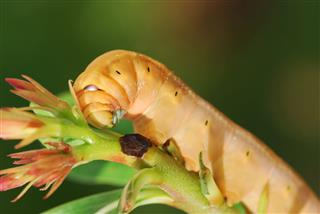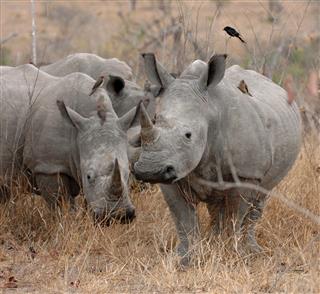
Scientific classification of animals is a very detailed, Latin-laden subject of study. This article provides a brief insight into the different phyla under which various animal species are classified.
The principle of scientific classification of various species was introduced by Carl Linnaeus (or Carolus Linnaeus), who is called the father of modern taxonomy.
Animal kingdom classification is not a job for the faint-hearted, for it is a really long list of classes and subclasses, many of which are named in Latin. There are millions of animal species on the Earth, and they are segregated under the kingdom Animalia, which in turn is divided into subkingdoms, infrakingdoms, superphyla, and phyla. Each phylum is further divided into class, order, family, genus, and species.
So, all animals ranging from single-celled microorganisms to highly complex, multi-celled organisms are classified into different phyla. It will definitely not be easy to capture 3.5 billion years of evolution in one small article, but let’s give it a shot. My attempt at this categorization should help you with the basics.
Please note that this article will only explain the main phyla, and not the class, order, family, genus, and species. The term ‘phylum’ is defined as a taxonomic category that ranks above class and below kingdom. In general, it can be said that animals with similar body plans are classified in a particular phylum.
The kingdom Animalia is divided into three main sections – Subkingdoms Radiata and Bilateria, and Phylum Myxozoa. The Subkingdom Radiata has four phyla, whereas Subkingdom Bilateria is divided into two infrakingdoms – Deuterostomia and Protostomia. Infrakingdom Deuterostomia consists of four phyla. Infrakingdom Protostomia has four superphyla – Ecdysozoa (with 8 phyla); Lophozoa (with 8 phyla); Platyzoa (with 8 phyla); and Chaetognathi (single Phylum Chaetognatha).
Phylum Myxozoa – Ciliated Protozoans
This phylum has a group of minute, but multicellular, parasitic, aquatic animals. It is further divided into two classes – Malacosporea (with a spore size of 10 μm to 20 μm) and Myxosporea (with a maximum size of 2 mm). Some of the common parasites that infect fish such as salmon, catfish, carp, and trout, are actually myxozoans. Some myxozoans infect amphibians, reptiles, and mammals. Even humans can be hosts of certain myxospores.
Phylum Chordata – Chordates
This phylum has some of the most familiar animals, including mammals such as humans. It has vertebrates such as reptiles, birds, and mammals; marine invertebrates such as sea squirts and sea tulips; and segmented marine animals (such as lancelets) with elongated bodies. Along with hagfish, vertebrates comprise the subdivision Craniata. Others include tunicates (Urochordata) and lancelets (Cephalochordata). Characteristic features of chordates include a notochord, a hollow dorsal nerve cord, pharyngeal slits, and a post-anal tail. Most of these animals are found to have one or more of these features, at least for a short period during their life cycles.
Class Mammalia – Mammals

These animals have hair or fur, and are capable of regulating body temperature, give birth to fully-formed babies, and produce milk to feed their young ones. Examples of mammals are monkeys, dogs, elephants, hippopotamuses, squirrels and other rodents, koalas, kangaroos, and humans. Marine mammals include whales and dolphins.
Class Amphibia – Amphibians

Amphibians lay eggs, usually in water. Most of them breathe through the lungs and skin. While some have gills, there are certain amphibians that breathe only through the skin as they lack lungs. These animals cannot regulate their body temperatures and can live both on land and in water. While some species are arboreal, there are some fossorial amphibians too.
Class Reptilia – Reptiles

Reptiles have roamed the Earth before the age of dinosaurs, and these animals adapt well to changes in the environment. Dinosaurs were actually a clade of reptiles known as Dinosauria. Examples of extant reptiles are alligators, crocodiles, lizards, snakes, tortoises, etc. These animals cannot regulate body temperature on their own. Other features include dry skin covered with scales and amniotic eggs.
Class Aves – Birds

There are over 8000 different species of birds that include parrots, sparrows, pigeons, geese, sea gulls, etc. They have feathered wings, which enable them to fly; beaks without teeth; and light bones that make their flight easy. Birds can breathe even at high altitudes, and they lay hard-shelled eggs.
Fish

Water is home to more than 20,000 different types of fish. They have gills and lack limbs. Earlier fish belonged to the class Pisces, but this classification is not in use anymore. Some examples of fish are sharks, goldfish, and herring.
Phylum Echinodermata – Echinoderms

The echinodermata phylum consists of animals such as star fish, sea urchin, sea cucumber, etc. The phylum has around 7000 species of marine animals with pentamerous (five-point) symmetry. Most of these animals are star-shaped, spherical, or elongated. Most of them have a spiny exoskeleton and lack a distinct head. Locomotion is achieved with the help of tubed feet.
Phylum Hemichordata – Hemichordates
The phylum has around 100 species that possess some of the characteristics of chordates. This is why the phylum is named Hemichordata. The characteristic feature of these marine animals is that their bodies are divided into three parts – the anterior part with a preoral lobe, a collar, and the trunk. Acorn worms are among the prominent members of this phylum. They are solitary, worm-like organisms that live in burrows. Others include pterobranchs (seen in colonies) and graptolites.
Phylum Xenacoelomorpha
This is a new phylum that has xenoturbellids and acoelomorphs. It has been discovered that these simple marine worms are closely related to sea urchins and even humans. So, it was decided to classify them under the infrakingdom Deuterostomia. Though xenoturbellids and acoelomorphs have a simple body structure, scientists believe that they have a common ancestor. It is also believed that the other complex deuterostomes descended from this ancestor.
Phylum Cnidaria – Jellyfish, Sea Anemones …

Commonly known as Cnidarians, there are around 9000 species of aquatic animals in this phylum. Most of them are found in marine water, and many have specialized stinging organelles. The most popular Cnidarians are jellyfish, sea anemones, corals, and Portuguese man-of-war. This group usually consists of two types of animals, namely the polyps (fixed, solitary, or colonial life) and medusae (free-swimming). Reproduction is asexual (budding) in polyps and sexual in medusae.
Phylum Ctenophora – Comb Jellies

Otherwise known as comb jellies or sea walnuts, Ctenophores are marine animals with gelatinous bodies. They have hair-like cilia that help them swim. These tufts of cilia have a comb-like appearance, and so, the animal got the name comb jelly. There are around 100 to 150 species of Ctenophores, and most of them are hermaphrodites.
Phylum Placozoa
Placozoans are non-parasitic, multicellular animals that are considered as the most simplest form of invertebrates. The body of a Placozoan is made of thousands of cells that are arranged as a plate with two layers. The flattened body of a Placozoan has a thickness of around a millimeter, and it moves with the help of cilia. Though it is believed that the phylum has a single genus Trichoplax, with a single species Trichoplax adhaerens, it has been speculated that there are more placozoans in the world. Treptoplax reptans is another species that was described in 1896. However, the organism was not seen after that year.
Phylum Porifera – Sponges

This phylum consists of simple multicellular animals that are mostly found in aquatic habitats. A typical sponge has pores known as ostia, found all over the body, and a large opening on the top, called the osculum. The body cells are held together so loosely that they do not form tissues. Food and oxygen are circulated through the numerous channels in the body. Reproduction can be sexual or asexual. There are around 15,000 extant species that are categorized into three classes. There is a fourth class that consists of some extinct species.
Phylum Arthropoda – Insects, Arachnids, Crustaceans …
With more than a million described species, Arthropoda is considered the largest phylum in the animal kingdom. All arthropods have jointed legs and visible exoskeletons that are shed periodically. Examples of arthropods include arachnids (scorpions, spiders, etc.); insects such as wasps and weevils; crustaceans (crabs and lobsters); and myriapods such as centipedes and millipedes. Arthropods have a bilaterally symmetrical body, that is segmented into the head, thorax, and abdomen. The jointed legs enable easy walking, swimming, feeding, and feeling. Book lungs form the respiratory organ in these animals.
Phylum Kinorhyncha – Mud Dragons
This phylum is made up of around 15 species of marine invertebrates that dwell in mud or sand. Commonly known as mud dragons, these animals have a length of less than one millimeter. The body of a Kinorhynch has 13 segments with numerous spines. The outer membrane secretes a tough cuticle, which is shed several times, till the organism turns into an adult.
Phylum Loricifera
There are around 100 species of Lorciferans that are microscopic animals which are found in marine sediments. Though a Lorciferan is microscopic, its body is made up of around 10,000 cells, and it has a brain, digestive system, excretory organs, and a host of specialized organs. It has a protective outer covering that helps the organism to attach itself to gravel.
Phylum Nematoda – Roundworms

This phylum consists of numerous species with varying habitats. Many of them are parasitic in nature. Ascaris, filarias, hookworms, pinworms, and whipworms, are some nematodes that are parasitic on humans. Some are beneficial for pest control, and they are used for biologic elimination of certain insects. They have tube-like bodies with a round cross-section; longitudinal muscles and a tough cuticle.
Phylum Nematomorpha – Horsehair Worms
This phylum has around 200 species of long, slender worms that are found in different parts of the world. While most of them inhabit fresh-water habitats, some are found in marine waters too. They are endoparasitic in aquatic crustaceans and arthropods during their larval and juvenile stages. They look similar to nematodes and hence, the name Nematomorpha. These organisms have a length of around 50 to 100 centimeters, and they are found to tie themselves in knots. So, they are also termed as Gordian worms (derived from the Gordian knot).
Phylum Onychophora – Velvet Worms
There are more than 100 species of terrestrial, worm-like organisms in the phylum Onychophora. They have slightly flat cylindrical bodies and multiple stub feet that are hollow. They have slime glands which produce adhesives that harden rapidly. These organisms squirt the slime at their prey and entangle the latter.
Phylum Priapulida – Penis Worms
These marine worms are named after their eversible proboscis, which is shaped like a penis. So, the phylum is named after the Greek God of fertility – Priapus. These worms are mostly seen in shallow waters and mud. They can be seen in varying sizes that may range from 1 mm to 40 cm. A penis worm has a cylindrical body, and its proboscis has longitudinal ridges.
Phylum Tardigrada – Water Bears
As the name rightly suggests, the organisms that make up this phylum live in water. These organisms can tolerate a wide range of extreme temperature and pressure. They can also withstand strong radiations that are more than lethal for humans. A Tardigrada has a segmented body and eight legs. There are around 1200 species in this phylum.
Phylum Annelida – Segmented Worms

This group consists of segmented worms, such as earthworms and leeches. There are around 17,000 species of annelids that are found in a wide range of habitats. While some are terrestrial, others can be found in freshwater as well as the marine environment. Most of the segmented worms have soft bodies that are bilaterally symmetrical. Each segment has bristles (known as chaetae) which help them move. While reproduction is usually sexual, they can also regrow broken body segments.
Phylum Brachiopoda – Lamp Shells
These marine organisms resemble clams in appearance. There are around 300 species of Brachiopods which are usually found in the extreme cold waters in the depth of oceans. Each individual has two unequal shells that are located on the upper and lower sides of its body. The shells are joined at the rear part, while the front remains open. There are two types of Brachiopods – articulate and inarticulate. Articulates have toothed hinges, whereas inarticulates have untoothed hinges.
Phylum Bryozoa – Sea Mats

This phylum has around 4000 aquatic invertebrate animals that are often found to live in colonies, that are attached to substrates. The members of each colony are found to be genetically identical. Each individual has a length of around 0.5 mm, and has a specialized structure (called lophophore) that helps it in filter feeding. The retractible lophophore has tentacles with cilia. While most of the species are colonial, the phylum has some solitary species too. Certain species discovered recently, float instead of attaching themselves to substrates.
Phylum Kamptozoa (Entoprocta) – Goblet Worms
These tiny, transparent aquatic animals have goblet-shaped bodies with long stalks. The goblet-shaped part has tentacles with cilia. These tentacles move and generate water currants, so that food particles can be drawn into the mouth. Both the anus as well as the mouth are located in this part. While most of them grow in colonies, certain species are solitary. There are around 200 species in this phylum.
Phylum Mollusca – Molluscs

With around 100,000 species, Mollusca is the largest phylum of marine animals. This phylum includes slugs, snails, squids, mussels, clams, and even octopuses. Slugs and snails make up 80% of the phylum. Most of the molluscs have a strong, muscular foot that helps them to swim, attach themselves to substrate, and burrow. They possess a rasping tongue that can rip off materials. While a majority of them are marine, some are terrestrial and others live in freshwater. Those living in water breathe through gills, while those living on the land have fully developed lungs.
Phylum Nemertea – Ribbon Worms
Also known as proboscis worms, there are around 1200 species in the phylum Nemertea. Members of this phylum are found across the world, and many of them inhabit marine waters. They have long, thin bodies with the mouth at one end, and the anus at the other. They have a proboscis that is almost as long as their bodies. It is kept inside the cavity called rhynchocoel. The organism ejects its proboscis so as to catch prey.
Phylum Phoronida – Horseshoe Worms
Like Bryozoans, Phoronids are marine animals that indulge in filter feeding, using their lophophores. The body of a horseshoe worm has three parts – the lophophore (with tentacles) located near the mouth, the tube-like trunk, and a flask-shaped bottom (ampulla). Food is drawn into the mouth by the lophophore, which is also responsible for gaseous exchange. Digestion happens in the ampulla. When threatened, the animal may retract into the ampulla.
Phylum Sipuncula – Peanut Worms
This phylum has around 150 to 200 marine worms that are mostly found in deep oceans. These unsegmented worms have cylindrical trunks, and a retractible anterior part called the introvert. The mouth, which is located at the tip of the introvert, is mostly surrounded with tentacles. When threatened, these worms retract their bodies and resemble peanut kernels in shape. So, they are also called peanut worms.
Phylum Acanthocephala – Spiny-headed Worms
There are around 1150 species of parasitic worms in this phylum. They have a retractible proboscis which is globular or cylindrical in shape. The proboscis has spines that are used for burrowing into the gut of the host. The spines are also beneficial for holding on to the gut wall. Even the body of this worm may have spines. During the early stage of their lives, these worms live inside invertebrates, and later they inhabit the gut of vertebrates.
Phylum Gastrotricha – Gastrotrichs
This phylum has around 700 species of small, worm-like organisms that are found in both marine and freshwater habitats. Some species are terrestrial and can be found on land. The body of a gastrotrich is covered with spines, bristles, or scales. Most of them have adhesive glands, which help them get attached to substrates. The cilia on their bodies aid movement. The body is spindle-shaped and ventrally flat, and the head is less distinct.
Phylum Gnathostomulida – Jaw Worms
This phylum has a few species of microscopic marine worms that inhabit the mud and sand in shallow coastal waters. Most of them have a maximum body length of 1 mm, and are slender. They have a ciliated covering and the cilia help them in movement. The mouth is located beneath the head. The characteristic feature of these worms is their muscular pharynx with strong jaws that are shaped like forceps. Hence the name jaw worms.
Phylum Micrognathozoa
This phylum has a single genus that has only one species – Limnognathia maerski. These microscopic animals are found in the homothermic springs located in Disko Island, Greenland. They are among the smallest animals on the Earth, as they have a length of around one-tenth of a millimeter. Though minute, this organism has a large brain and a jaw that has 15 separate segments,
Phylum Orthonectida – Orthonectids
This is also a small phylum with a few small parasitic animals. They are multicellular animals that are parasitic on marine invertebrates. These ciliated animals move freely inside the bodies of their hosts. The phylum has around 20 species that are classified into two families.
Phylum Platyhelminthes – Flatworms

This phylum has around 30,000 species with unsegmented, flat, soft bodies. While some species are free-living, many are parasitic in nature. Parasitic flatworms have a complex life cycle with multiple hosts. Flatworms derive nutrients and oxygen through their body surfaces, and they lack body cavities. Flukes and tapeworms belong to this phylum.

Phylum Rhombozoa (Dicyemida)
This phylum has tiny parasites with simple body structures. The body of a Rhombozoan is made up of an axial cell that is covered with ciliated cells. The organism uses the anterior part of its body to attach itself to the renal appendages of cephalopods. In short, Rhombozoans are parasitic on cephalopods.
Phylum Rotifera – Rotifers

Rotifers are free-living, aquatic animals that are microscopic in size. The phylum has around 1700 species, and most of them are found in freshwater bodies. While some are sessile, other move freely. These animals have varying body shapes, but are mostly cylindrical. Their characteristic feature is the corona with a ring of cilia, on the head.
Phylum Chaetognatha – Arrow Worms

The phylum has around 125 species of predatory marine species. Most of them have long, transparent bodies. The body of an arrow worm has a distinct head, trunk, and tail. It has hooks and spines on both sides of its head. These carnivorous animals use these hooks and spines for catching prey.
This is only a brief overview about classification of animal species. With millions of animal species on the Earth, it is difficult to describe each class, order, family, genus, and species. Hope the article has helped you understand how different types of animals are classified under different phyla.


















